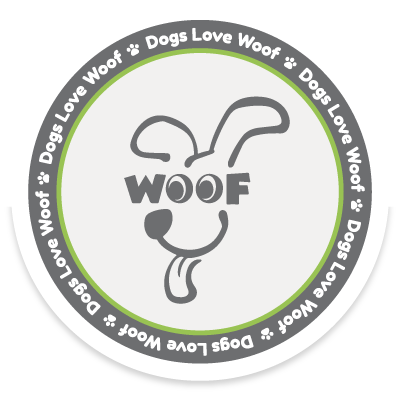I find there are two kinds of owners when it comes to dog food. The owners who say, “I would NEVER give my dog people food!” And the owners who slip something off their plate every time they see those sweet puppy dog eyes.
I have to admit, I am the plate-slipper kind of owner.
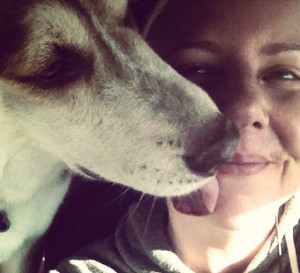
Here she is licking salt off my face, like the walking food source that I am.
While treats are a matter of taste, picking the right dog food is a lot tougher. We are in the age of choices, and deciding between aisles upon aisles of kibbles, raw diets, freeze-dried and frozen meals – it’s hard to know what to do.
When I was doing my research for this blog, I messaged all my veterinary friends to get their take on how to choose a dog food. Their responses showed what a hot-button issue it has become. “You’re so brave to write about that!” they said. And I got more than a few “I’m staying out of that one!” Some named a couple brands that they personally use, but wouldn’t necessarily recommend for everybody. (Which makes sense because not all dogs should eat the same food.)
But I do think there is a place we can all start from when choosing a dog food. (Yes, I am going there, vet friends.) Please be kind and know that I am just going over some basics and that I fully encourage you to do your own research. And, as always, consult with your vet because some dogs have very specific nutrition requirements based on their health.
AH, THE PURINA DAYS
When I was a kid, dog food was easy. There was Purina, Alpo and Milk Bones. That’s it. And if you gave your dog anything else, you were “spoiling” them. As long as the packaging had a picture of a dog and a wagon on it, you were good to go.
THEN WE GOT WISE
Fast forward a few decades and enter the era of the informed pet owner. No more cheap dog food for us. (Or horse meat? Was that a real thing?) We wanted to do better. And just like everything else that used to seem simple (kid’s birthday parties come to mind) the internet has enabled us to more easily share ideas. That’s a good thing! But the dark side of the internet is that it has also allowed us to more easily compare ourselves with others, and awakened a forum for the competition of who can be the best. The Best Mother! The Best DIY-er! The Best Pet Owner! (That’s me, by the way.) Look at any blog or Instagram and you can see this competition playing out in real time.
For example, my refrigerator looks WAY BETTER than this one from the internet.
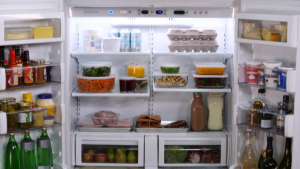
In your face, @marthastewart.
THE BASICS
So there is a lot of noise out there. I think a good place to start is with the VERY basic. What are dogs supposed to eat? Are dogs carnivores, herbivores or omnivores? (Surprise, surprise – there is controversy about this subject too!) I found a good article addressing this question, which claims the following:
– It is believed that all dogs originated from the timber wolf about 15,000 years ago
– Wolves are definitely strict carnivores (nothing but meat)
– Domesticated dogs are not exactly wolves, but share a lot of their traits – therefore they are carnivores too
– Dogs’ carnivorous traits include sharp teeth, front to back (no square molars to grind grains); the absence of salivary amylase, the enzyme herbivores and omnivores have to help break down starchy carbs into simple sugars; and a higher concentration of stomach acid that aids in digesting meat and protecting them from bacteria in decaying meat.
– Although dogs are basically built to be carnivores, over the years they have adapted to eat non-meat foods, including scraps from their owners’ cast-off meals, whatever they could scavenge and, more recently, commercial dog foods.
Read the entire article here and decide for yourself.
BUT ARE DOGS REALLY LIKE WOLVES?
Carnivorous wolves they may be, dogs have become highly functioning omnivores. And let’s be honest, thanks to their incredibly malleable genome and years of human tinkering, most domesticated dogs don’t look anything like their lupine ancestors.

Real wolf.
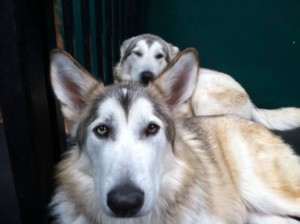
Native American Indian Dogs. (A mix of wolf, Siberian Husky, German Shepherd and Malamute.)

And English Bulldog Luca, who is the cutest wolf I’ve ever seen.
LET THEM EAT MEAT! (BUT ONLY MEAT?)
Now that we know dogs are carnivores, but have adapted to also eat grains and vegetables, we are faced with a choice. Do we stick with an all-meat diet? A raw-food diet? Or do we “compromise” and buy a more convenient kibble that has ingredients other than meat? I think that depends on your dog and your lifestyle.
Dogs, like us, are all individuals and their dietary needs are going to be different. There is going to be some trial and error. (For some people, just finding a dog food that doesn’t make their dog itchy or have diarrhea is a feat in itself.)
And committing to an all-meat regimen is no easy task. I had a hard time finding an all-meat kibble online. (I did find a Real Meat Pet Food site, where a 10-pound bag of beef dog food was about $100.) Even brands like Instinct and Taste of the Wild are “grain-free” but still contain vegetables, and in some cases, fruit (and other stuff).
Feeding raw meat is do-able, but can be difficult. It’s expensive, it’s tricky to store, and it’s hard on some dog’s digestive systems.
Unless you’re going to cook every day, you’re going to have to find yourself a decent kibble. This is when we enter the crazy world of canine marketing. What should you look for? What ingredients are acceptable?
FINDING A GOOD KIBBLE IS ALL ABOUT READING LABELS
We stand in the pet food store and stare at the shelves. We read labels, scratching our heads because they all have ingredient lists a mile long. We choose the lesser of all the evils and still feel a little guilty. (At least I do.)
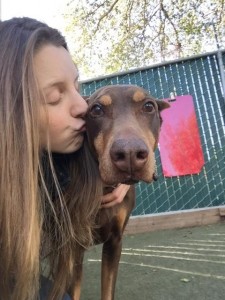
And we really want to do better.
You have to read dog food labels with a discerning eye. By law, food manufacturers are supposed to list the largest percentage of what’s in the food first. So I am always looking for foods that start with some kind of meat ingredient. Be wary of the word “meal.” Meal is a Frankenstein-like meat monster. “Chicken meal,” for example, is suspect because by law it is allowable to use “4D chickens” to make this meal – the four D’s being dead, dying, diseased or disabled.
Next, the fewer ingredients the better. Although they will have to add some kind of preservative to keep the kibble fresh on the shelf, tons and tons of chemicals are not what your dog needs.
Basically, choose food for your dog that you would choose for yourself. Real, whole foods are best. Compromise wisely.
And by all means, slip your dog a piece of boneless, skinless chicken off your plate once in a while. Because, despite what you’ve heard, people food is dog food.
Take it from me, the Best Pet Owner on the Internet.
What do you feed your dog?
